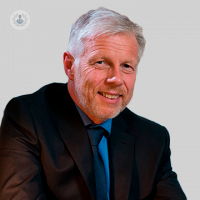Haemorrhoids and the Rafaelo® procedure
Written in association with:Internal haemorrhoids are typically painless even if they are bleeding. They are far enough inside the rectum that you won’t be able to feel or see them. You might, however, see bright red blood on your toilet paper, which may leave you feeling worried. Wondering what you can do to get rid of them?
The Rafaelo® procedure is a relatively new minimally invasive treatment of internal haemorrhoids. It uses a safe and painless radiofrequency energy to shrink or to eliminate the haemorrhoid and is similar to the radiofrequency treatment used to for varicose veins. Here, consultant surgeon Mr Andrew Clarke explains how the procedure works and what happens during recovery.

How is the Rafaelo® procedure performed?
Rafaelo® is usually performed using a local anaesthetic or a mild sedative. Occasionally patients choose to have their treatment under a general anaesthetic as a day case. The patient lies on their left side and a small plastic tube (proctoscope) is inserted into the anal canal. Local anaesthetic is injected into the haemorrhoidal cushion and a small needle probe is inserted into the haemorrhoid.
Radiofrequency energy then reduces the blood supply causing it to necrose, which shrinks the haemorrhoid or causes it to fall off. Typically the procedure takes around 20-minutes to perform.
What are the risks of the procedure?
The Rafaelo® technique is a low-risk procedure that avoids staples or excision with scarring. Most patients don’t experience much pain or discomfort, but some patients may experience discomfort, bleeding and discharge following the operation, which in the vast majority of cases settles spontaneously. Rarely, anal fissures or more significant rectal bleeding may occur. Patients may be given some painkillers to help with any discomfort following the procedure.
What happens during recovery?
The Rafaelo® procedure has an advantage over other procedures as following treatment most patients experience a more rapid recovery and require just a few days to fully heal. The treatment can be conducted on a ‘walk in, walk out’ basis. Patients are discharged with simple painkillers and most are able to return to unrestricted activity within a couple of days or so.
If you would like to discuss your treatment options for haemorrhoids, do not hesitate to book a first consultation with Mr Clarke.



